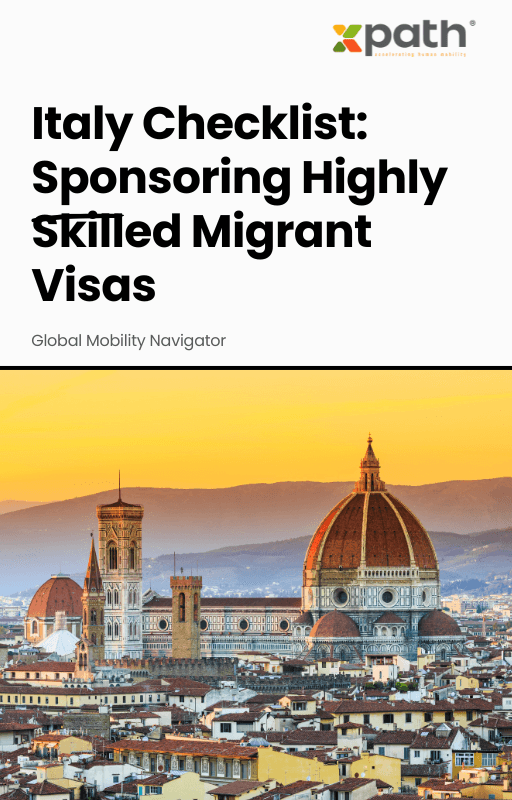Italy Checklist: Sponsoring Highly Skilled Migrant Visas
Grab a copy of a guide to international employee relocation
View E-bookIf you’ve ever dipped your toes into the world of international assignments, you probably know that moving employees across borders goes way beyond visas and plane tickets. There’s a thicket of paperwork, payroll headaches, and one enormous question: What happens to everyone’s social security contributions? Enter the game-changer—Social Security Totalization Agreements with the U.S. For global mobility professionals and companies expanding their footprint, these pacts can be the difference between smooth sailing and a bureaucratic storm. Let’s dive into how these agreements supercharge global mobility solutions and keep your talent happy, compliant, and mobile.
Imagine an employee from Germany on assignment in New York. Do they pay into German Sozialversicherung, U.S. Social Security, or both? Without some kind of bridge, employees posted internationally could face the burden of contributing to two systems—ultimately earning less and companies paying more. Social Security totalization agreements tackle this head-on. These are bilateral treaties between the U.S. and other nations designed to eliminate dual social security taxation and help mobile employees qualify for benefits. The U.S. currently has such agreements with 30 countries, stretching from Australia to Belgium, Switzerland to Japan.
In an age where the global talent pool is both a business asset and a competitive necessity, every HR and mobility leader is looking for ways to streamline assignments and keep costs in check. Dual contributions can quickly erode assignment budgets—sometimes adding up to tens of thousands of dollars annually per employee. For staff, the lack of contribution continuity also means confusion and potential loss of benefits upon retirement. These agreements solve for both: preventing double contributions and linking social security eligibility between the U.S. and partner countries.
Let’s get real with the data. According to the U.S. Social Security Administration, roughly 300,000 workers and their employers benefit from totalization agreements every year. A survey by Grant Thornton found that for multinationals, compliance costs related to social security can climb as high as 15% of base salary per assignee when no agreement exists. However, with totalization agreements in place, companies can reduce these costs dramatically and lower legal risk. Also, the World Economic Forum notes that global mobility has nearly doubled in the last two decades, so the value of these agreements is only growing.
Let’s put theory into action. A large engineering firm recently expanded operations into the U.S. from the UK. Without the U.S.-UK totalization agreement, their expatriate engineers would face roughly $10,000 each in double contributions annually. By using the agreement, their global mobility team (with support from platforms like xpath.global) filed for certificates of coverage, ensuring staff would only pay into one country’s system for the length of their U.S. assignments. The move saved the company hundreds of thousands of dollars over a multi-year project rollout—and gave their talent confidence about future benefits.
Sounds pretty straightforward, right? Not always. Each agreement is unique—what works with France may not apply to Brazil. Keeping up-to-date with which countries have agreements, understanding each pact’s terms, and making sure assignees have the proper certificates is a hefty lift. Even a minor slip-up can result in unexpected tax bills or lost benefits. That’s why global mobility leaders are turning to specialized platforms like xpath.global, which centralize compliance documents, automate reminders, and help generate the needed certificates in a few clicks. As assignments rise and rules change, digital tools are becoming the backbone of global mobility compliance.
The winds are changing fast. As more companies embrace remote work, short-term assignments, and cross-border project teams, the complexity of managing social security has never been greater. Tools that streamline processes, track global agreements, and help companies pivot quickly will define tomorrow’s leaders in global talent mobility. Digital mobility solutions—especially those that integrate compliance, document management, and analytics—are fast becoming the industry standard. That’s why a partnership with innovative mobility providers is less an option, more a necessity.
If your company’s global mobility plan doesn’t account for social security totalization, you may be leaving money—and goodwill—on the table. These agreements clear an essential path for international assignments, making it possible for organizations to move talent efficiently and cost-effectively. With the right knowledge and digital partners on your side, you can keep assignments on track, attract top talent, and sleep easy knowing you’re on the right side of cross-border compliance. Consider partnering with xpath.global to see how you can supercharge your mobility strategy and keep your business ahead of the curve.
What is a social security totalization agreement?
It’s a bilateral treaty between the U.S. and another country that prevents dual social security taxation for people working temporarily abroad and helps link together benefit eligibility from two countries.
Which countries have totalization agreements with the U.S.?
The U.S. has agreements with 30 countries, including Canada, the UK, Germany, Australia, and South Korea. Check the Social Security Administration’s website or tools like xpath.global for the latest list.
How does a totalization agreement benefit employers?
It dramatically lowers the cost of assignments abroad by eliminating dual contributions, making international relocations more affordable and compliant.
How do employees avoid dual contributions?
Typically, by filing for a certificate of coverage before departure, which proves to the host country that the employee is covered by the sending country’s system.
How can technology help with totalization agreement management?
Platforms like xpath.global automate compliance tracking, document management, and notifications, simplifying the process and reducing risk.
Ready to transform your mobility program? Explore xpath.global’s solutions.

Italy Checklist: Sponsoring Highly Skilled Migrant Visas
Grab a copy of a guide to international employee relocation
View E-book